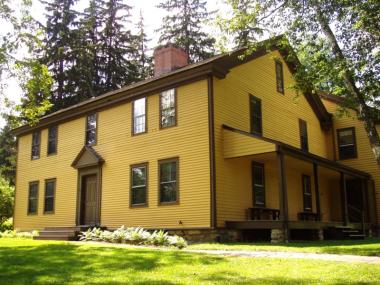Visiting a writer's house museum offers an ambulatory version of the pleasures of reading. Drawn inside the world of another's making, we find our world becoming more intelligible, more our own.
Restored writers' houses are easy to find: over 70 museums dot the United States. Among the houses that afford literary travelers this thrill of discovery, and a mini-course in history, are the Walt Whitman House in Camden, N. J., just across the river from Philadelphia, and Herman Melville's Arrowhead in Pittsfield, Mass., in the historic Berkshires.
"People stand in the doorway of the study in hushed reverie," said Catherine Reynolds, curator at Arrowhead. "I've seen crusty old men get tears in their eyes." But fans too often miss Arrowhead. "People don't look for Melville in Western Massachusetts," notes Reynolds. And when they find him here, "they wonder what he was doing so far inland."
Melville said he had "a sort of sea-feeling here in the country." Outside the window of his second-floor study, you can find the land-locked inspiration for Moby Dick: a view of Mount Greylock, which Melville said looked like a double-humped whale.
Melville bought Arrowhead, a Georgian-style farmhouse built in 1780, in 1850. Parts of the original house are lost, but parts remain intact. Arrowhead was crowded with Melvilles: between 1850-1863, when Melville lived there, it housed his wife, four children, his mother and three aunts. He added to the house as he added to his oeuvre: as he wrote Nathaniel Hawthorne, "I have been building some shanties of houses (connected with the old ones) and likewise some shanties of chapters and essays."
Many visitors are surprised by how small Arrowhead is and how little Melville earned. (His oft-anthologized short story "Bartleby the Scrivener" netted him only $36 in royalties.)
Like Melville, Walt Whitman struggled financially. And people are surprised to find Whitman in Camden, too. In fact, people have been surprised to find him there since 1883, when his home was just Walt's house, not the Walt Whitman House, New Jersey Division of Parks and Recreation. Whitman, who moved to Camden in 1873 to live with his brother George and his ailing mother, bought the modest two-story row house on Mickle Street for $1,750 in 1883, after his mother had died and George had moved away.
Always on the verge of destitution, Whitman managed to use royalties to buy the house, the only one he ever owned. He received many visitors here, including Oscar Wilde, Robert Louis Stevenson and Charles Dickens. Like many contemporary visitors, they couldn't figure out why Whitman lived in Camden, which was then, as now, a depressed town overshadowed by Philadelphia, its neighbor across the Delaware River. Of his "plain, weather-beaten house" Whitman explained: "I like the folks, the plain, ignorant, unpretentious folks; and the youngsters that come and slide on my cellar-door."
In contrast to the foreboding concrete buildings nearby, the modest house retains much of its 19th-century character. Cobblestones remain on the parking strip in front, which offers visitors a glimpse of period style: small rooms brightened by whimsical, often clashing wallpaper and rugs. By a stroke of luck, the Whitman House has become one of a handful of historically preserved 19th-century working-class houses.
Whitman advised us, "If you want to find me again, look for me under your bootsoles." Next time you're near an author's house, pull off the road and take a tour. For less than the price of a paperback, it'll be well worth the visit.



